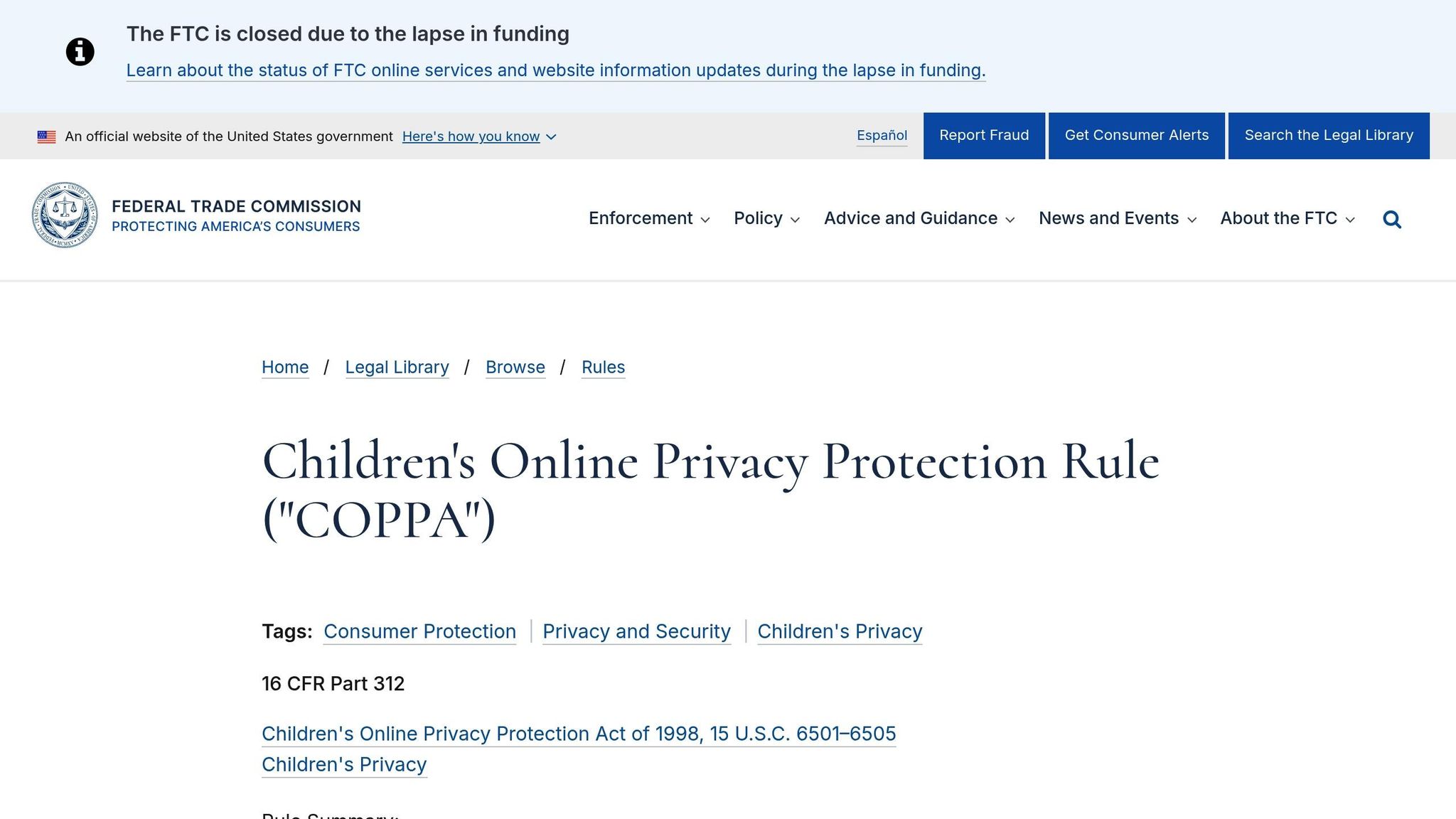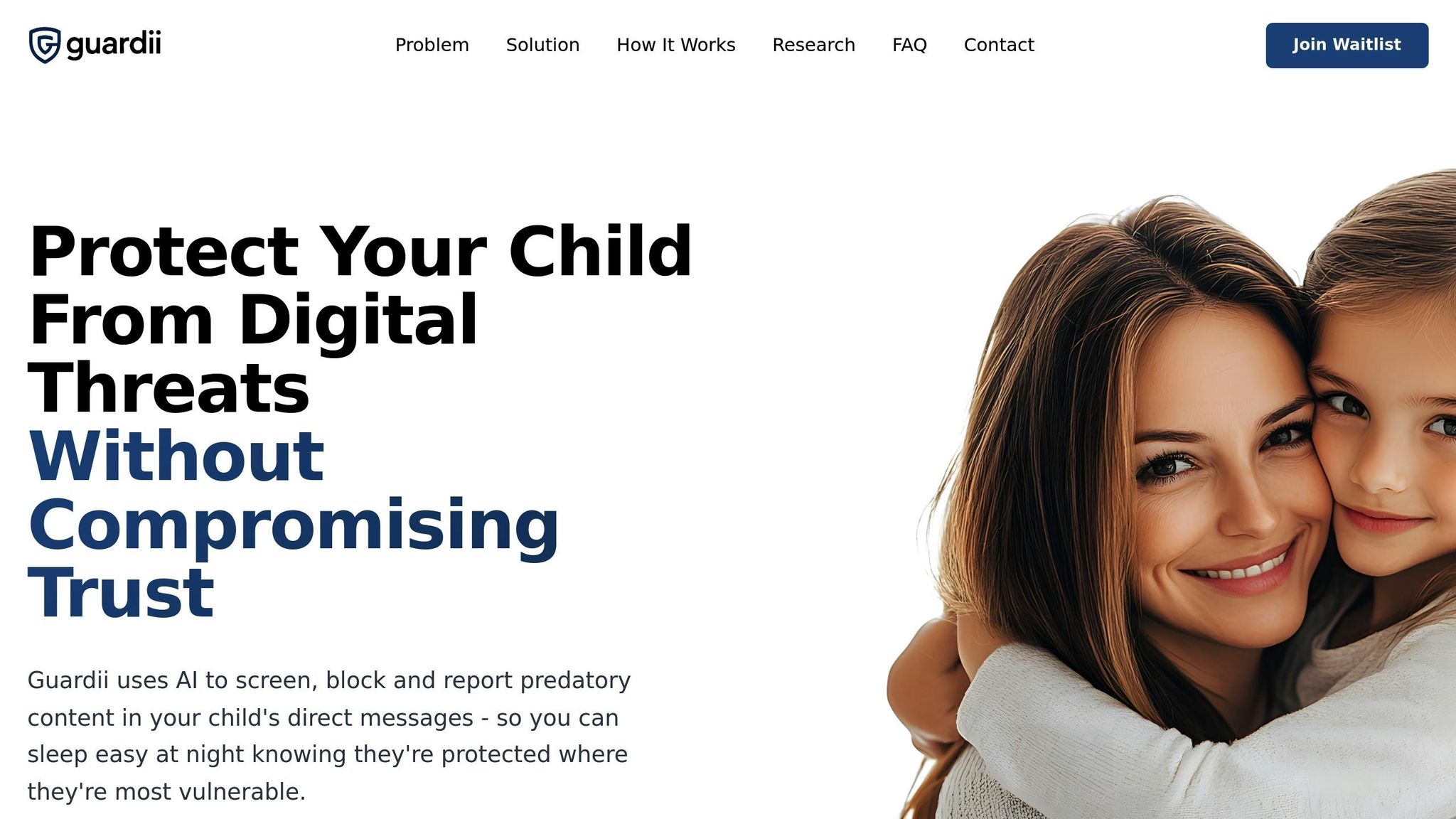
COPPA and AI: Child Data Compliance Explained
Key takeaway: COPPA (Children's Online Privacy Protection Act) sets rules for protecting children under 13 online. With AI platforms like Guardii, compliance becomes more complex due to advanced data processing, requiring stricter parental consent and transparency.
Highlights:
- Standard Services: Collect basic info (e.g., name, email) with straightforward parental consent methods. Challenges include verifying age and monitoring third-party compliance.
- AI Platforms: Analyze user behavior and sensitive data like voiceprints. Require detailed consent processes and stronger safeguards due to deeper data analysis.
Quick Comparison:
| Aspect | Standard Services | AI Platforms (e.g., Guardii) |
|---|---|---|
| Data Collected | Basic (name, email, age) | Behavioral data, biometrics |
| Consent Process | Simple methods (email, credit card) | Complex, involving detailed disclosures |
| Protection Approach | Reactive (post-incident) | Real-time monitoring, instant alerts |
| Cost | Lower compliance costs | Higher due to advanced tech |
Bottom line: AI tools offer advanced safety features but demand more effort to comply with COPPA. Transparency, limited data use, and regular audits are critical to ensure compliance while protecting children online.
COPPA Compliance with Spectrum Labs AI

1. Standard Online Services
Traditional online platforms like educational websites, gaming portals, and social media sites follow well-established protocols to comply with COPPA. These services primarily collect basic user information - such as names, email addresses, age, and location - through direct input from users. Understanding how these systems operate helps highlight how AI systems differ in complexity and approach.
Data Collection Requirements
In standard services, data is gathered directly from users or their parents via forms or registration processes. This straightforward method focuses on collecting surface-level details, making it easier to explain exactly what data is being captured and why. Unlike AI systems, which often analyze user behavior in-depth, these platforms stick to clearly defined data fields, ensuring transparency in their practices.
Once data is collected, the next step involves securing parental consent.
Parental Consent
Parental consent is typically obtained through methods like verified email addresses, credit card transactions, or phone confirmations. Parents are provided with detailed information about what data is being collected and how it will be used. They must actively confirm their consent within a specified timeframe. This system works because the data collection process is predictable, allowing privacy policies to clearly outline every aspect of the service's data practices.
After consent is granted, managing and eventually deleting this data becomes a key focus.
Data Retention Policies
Data retention policies are another critical component of compliance. Traditional services usually set defined retention periods - ranging from one to seven years - and provide tools that allow parents to request data deletion.
Because the data in these systems is organized and structured, the deletion process tends to be straightforward. For example, a child’s account details, chat logs, or uploaded files can be easily identified and removed from servers systematically.
Compliance Challenges
Even with simpler data structures, standard online services face several challenges in maintaining COPPA compliance.
One major issue is age verification. Determining whether a user is under 13 without collecting additional personal information creates a tricky situation, as children can easily provide false ages during registration.
Another hurdle involves third-party integrations. Many platforms rely on external tools like analytics services, advertising networks, or social media plugins. Ensuring these third parties also adhere to COPPA requires constant oversight and legally binding agreements.
Lastly, international users add complexity. Platforms must comply with different privacy laws across various countries while ensuring they meet COPPA standards for U.S.-based children. This often results in broad privacy policies that may fall short of addressing specific regional laws or expectations regarding child privacy.
2. AI-Driven Platforms (e.g., Guardii)

AI-driven platforms like Guardii are subject to stricter COPPA regulations due to their advanced data processing capabilities. These platforms work in real time to monitor communications, which brings unique challenges in safeguarding children's data. As a result, there’s a growing need to examine how these systems handle data collection and parental consent.
Data Collection Requirements
AI platforms operate differently from traditional services, requiring stricter protocols because of their ability to analyze data more deeply. For example, platforms like Guardii gather a wider range of information, including biometric data such as voiceprints and facial templates - both of which fall under COPPA’s expanded definition of personal information. Guardii uses AI-driven tools to monitor direct messaging platforms, aiming to detect harmful behavior while maintaining privacy protections for children.
Because of these extensive data practices, having strong consent mechanisms in place is absolutely essential.
Parental Consent
"The COPPA Rule, as adopted by the FTC in 2000 and updated in 2013, requires businesses to obtain verifiable parental consent before collecting, using or disclosing personal information from children under the age of 13."
Under COPPA, parental consent is required not only for the initial collection of data but also for any subsequent uses. Following the amendments set to take effect on June 23, 2025, platforms can verify parental consent using methods like knowledge-based authentication with dynamic questions or by requesting government-issued photo identification. These notices must clearly explain how data will be used and whether it will be shared with third parties. Importantly, consent for data collection does not automatically grant permission for data sharing.
sbb-itb-47c24b3
Pros and Cons
When it comes to COPPA compliance, both standard online services and AI-driven platforms like Guardii bring their own strengths and challenges to the table. Knowing these differences can help parents and organizations make smarter choices about protecting children's data online.
| Aspect | Standard Online Services | AI-Driven Platforms (e.g., Guardii) |
|---|---|---|
| Data Collection Scope | Limited to basic user information (e.g., name, email, age) | Focused on analyzing direct messaging content and behavioral cues |
| Real-Time Protection | Reactive measures implemented after incidents occur | Proactive threat detection with immediate blocking of harmful content |
| Parental Control | Basic account settings and usage reports | Advanced dashboard with actionable alerts and evidence preservation for law enforcement |
| Privacy Complexity | Straightforward consent processes | May involve more detailed consent protocols due to expanded data analysis |
| Implementation Cost | Lower compliance costs with simpler systems | Higher investment in advanced AI monitoring technology |
| Regulatory Burden | Adheres to standard COPPA requirements | May face additional compliance considerations as regulatory standards evolve |
Standard online services are often simpler and more affordable. They collect only basic information, which makes compliance relatively easy and keeps costs down. Their straightforward consent processes are a plus for many organizations. However, these services tend to be reactive - they address problems only after they've occurred. This delay can leave harmful interactions unaddressed for longer periods. Additionally, their reporting tools are fairly basic, which might not provide parents or organizations with enough detail to tackle risks effectively.
AI-driven platforms like Guardii, on the other hand, take a proactive stance. They monitor real-time activity, block harmful content instantly, and send immediate alerts to parents. Features like evidence preservation can even assist in legal actions, offering an extra layer of protection. But this level of sophistication comes with trade-offs. The expanded data analysis often requires more complex consent processes, and staying compliant with evolving regulations can be more demanding. Plus, the advanced technology behind these platforms generally comes with higher costs.
The best choice depends on individual needs. Families or organizations dealing with higher-risk online environments might find the enhanced protection of AI-driven platforms worth the investment. Meanwhile, those with less exposure to online threats may find that standard services strike the right balance between cost and functionality.
Conclusion
COPPA compliance has come a long way. While traditional methods provided basic safeguards, the rise of AI platforms has pushed the boundaries, requiring more proactive approaches. AI-driven systems now monitor behavioral patterns and content in real-time, enabling immediate action to address harmful scenarios. This shift from reacting to preventing issues is reshaping how we think about child safety online.
At the heart of compliance lies transparency. Parents deserve clear and straightforward explanations about what data is collected, how AI processes it, and what steps are taken to ensure safety. The consent process must directly address the broader scope of AI monitoring, ensuring parents feel confident about their child’s data security. Collecting only what’s necessary is equally important. Operators should resist the urge to gather excessive data for AI optimization, focusing instead on privacy principles and adhering to regulatory guidelines. Strict data retention policies should be in place, balancing safety needs with privacy concerns.
Strong technical safeguards are essential. AI systems should follow privacy-by-design principles, like limiting how long data is stored. Features for preserving evidence can be helpful for law enforcement, but they must be implemented carefully to avoid creating new privacy risks.
Regular compliance audits are non-negotiable. Technology evolves at breakneck speed, and regulatory interpretations shift just as quickly. Operators need to establish ongoing review processes to ensure their systems stay aligned with current legal and technological standards.
The growing investment in AI-powered child protection tools reflects an understanding that traditional methods alone can’t keep up with today’s online threats. While these platforms come with added complexity and cost, their ability to prevent harm before it happens marks a major step forward in safeguarding children in the digital age.
FAQs
How does AI technology like Guardii improve online safety for children?
AI tools such as Guardii are transforming online safety for children by providing real-time monitoring and identifying harmful content or predatory behavior. Unlike older methods that depend largely on human moderators, AI works tirelessly around the clock, spotting potential dangers before they become serious issues.
What sets Guardii apart is its ability to block inappropriate interactions while still respecting privacy. This creates a safer digital space where children and their families can feel more secure and at ease.
What challenges do AI platforms face in meeting COPPA requirements for protecting children's data?
AI platforms encounter several challenges in adhering to COPPA regulations. One major obstacle is securing verifiable parental consent before collecting or using personal data from children under 13. This involves setting up reliable systems to confirm a parent’s identity while ensuring the process remains user-friendly.
Another significant issue is maintaining data security and privacy. Platforms are tasked with protecting children's information from breaches, limiting how long data is stored, and offering parents the ability to review or delete their child’s personal details. On top of that, staying compliant means regularly updating policies and technical measures to align with changes in COPPA regulations.
Balancing these requirements while providing safe and innovative AI-driven services is no small feat, but it’s a critical step in ensuring children’s safety online.
Why do AI platforms need strict data retention policies, and how can they ensure both safety and privacy?
Strict data retention policies play a crucial role in helping AI platforms meet legal requirements, safeguard sensitive information, and minimize the chances of data breaches. These policies outline how long data is stored, why it’s collected, and when it should be securely deleted. Clear guidelines like these not only ensure responsible data management but also help build user trust.
For a proper balance between safety and privacy, platforms should keep data only for as long as it’s needed to fulfill operational or legal obligations. Adding layers of protection - such as encryption, strict access controls, and anonymization - can further secure user data while respecting privacy. These measures are especially important when handling children’s data, as they help establish trust with families and demonstrate a commitment to responsible data practices.